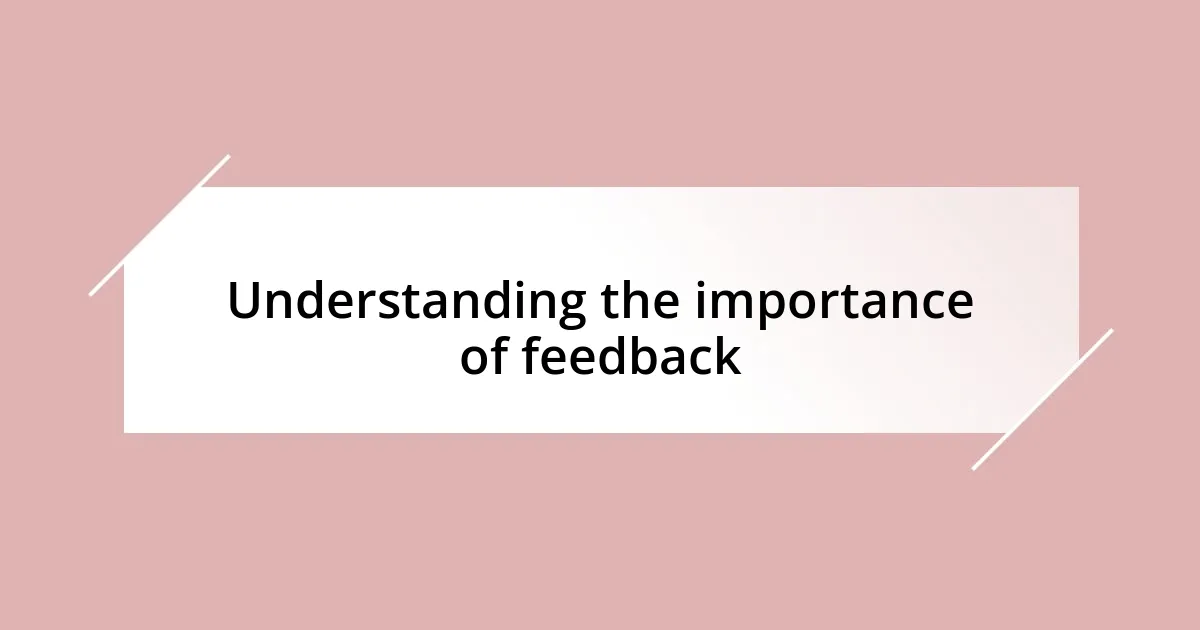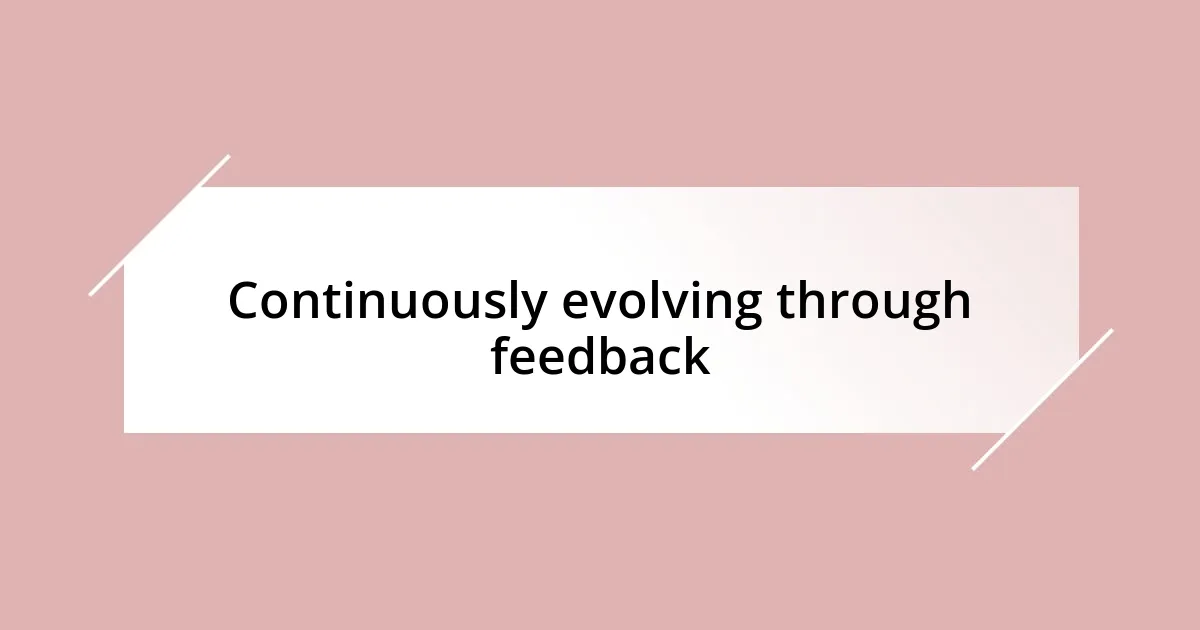Key takeaways:
- Embracing feedback transforms vulnerability into strength, allowing for personal and professional growth.
- Creating a safe space for feedback encourages honest insights, enhancing the feedback-gathering process.
- Analyzing feedback for patterns can lead to significant improvements in skills, such as writing and presentation styles.
- Measuring the impact of implemented feedback helps validate efforts and strengthen relationships within teams.

Understanding the importance of feedback
Feedback is more than just a tool for evaluation; it’s a catalyst for growth. I remember a time early in my career when I received constructive criticism on a project I was incredibly proud of. At first, it stung, but I later realized that those insights were invaluable in shaping my future work.
Have you ever felt that rush of excitement when someone acknowledges your strengths while pointing out areas to improve? It’s a powerful sensation. Embracing feedback, for me, has meant turning vulnerability into strength. I find that each piece of feedback can illuminate blind spots, steering me toward greater success.
There’s something enlightening about realizing that feedback is a two-way street. I once made a crucial mistake by taking feedback personally, but I learned that it’s not about me; it’s about my work. By reframing feedback as a lifeline for improvement, I can be more receptive and, ultimately, more effective in my pursuits.

Identifying areas for improvement
Identifying areas for improvement can be a transformative experience. I recall a pivotal moment when I received feedback from a mentor on my presentation skills. Initially, I felt defensive about my style. However, as I reflected on their suggestions, I recognized my tendency to rush through key points. This realization motivated me to slow down and engage my audience more effectively.
Sometimes, it’s about digging deeper. I remember compiling feedback from my team after a project launch. It was a mix of compliments and critiques, yet those critiques stood out. They highlighted my need to communicate more clearly during our brainstorming sessions. Embracing that pointed feedback helped me create a collaborative environment where every voice mattered.
When I started gathering feedback, I often focused on immediate issues, but now I aim for a broader perspective. I’ve learned to ask targeted questions to uncover specific areas for growth. For instance, I’ll often ask, “What aspect of my approach could be clearer?” This helps me align my efforts with expectations, ensuring I’m always evolving for the better.
| Feedback Type | Focus |
|---|---|
| General Feedback | Identifies overall strengths and weaknesses without specifics |
| Specific Feedback | Pinpoints exact areas needing improvement |
| Constructive Criticism | Focuses on growth potential with actionable steps |

Gathering relevant feedback effectively
Gathering relevant feedback effectively requires intention and a strategic approach. One of my favorite methods is to create a safe space for others to share their insights candidly. I learned this during a team project when I invited my colleagues to provide feedback anonymously. This approach resulted in honest and insightful responses that I might not have received otherwise. The experience taught me that when people feel secure, they’re more likely to provide genuine feedback, which ultimately leads to meaningful growth.
To enhance the process of gathering feedback, I rely on a few core strategies:
- Ask Open-Ended Questions: Instead of yes or no questions, I encourage expansive dialogue. For instance, “What did you think about my approach?” opens the floor for deeper insights.
- Encourage Constructive Criticism: I ask specifically for critiques by framing requests like, “What’s one thing I could improve on next time?” This invites targeted feedback.
- Follow Up: After receiving feedback, I make it a point to circle back to my colleagues to discuss how their insights influenced my improvements. This shows that I value their input and recognize its impact on my development.
Through these methods, I’ve found that relevant feedback flows more freely, enriching my personal and professional growth significantly.

Analyzing feedback for actionable insights
Analyzing feedback effectively is like uncovering hidden treasures. I vividly recall a situation where I received a survey after a training session I conducted. The responses were varied, but one pointed out that my pacing during the exercises felt rushed. Instead of dismissing it, I took a step back and asked myself, “Why did I speed through it?” This reflective questioning led me to realize I was so focused on covering all my material that I neglected the importance of allowing participants to absorb and engage with the content. By slowing down, my next session felt more fluid and inclusive, which ultimately created a better learning environment.
The art of dissecting feedback is not just about looking for mistakes; it’s about seeking patterns. I remember reviewing multiple pieces of feedback I received over several months regarding my writing style. I noticed a recurring theme: while my ideas were strong, my transitions often lacked clarity. This insight was pivotal. I started mapping out my thoughts before writing, crafting clearer pathways for readers to follow, enhancing their experience and making my writing more compelling. It was fascinating to see how one piece of feedback could lead to a significant shift in my approach.
As I analyze feedback, I’ve learned to filter through my emotional responses. Initially, I would feel a sense of dread when I saw critique, but now I ask myself, “What is the underlying message here?” This shift has profoundly changed my perception. For example, when a colleague commented that my reports lacked depth, rather than feeling deflated, I saw it as an opportunity to deepen my research and enhance my analytical skills. I’ve learned that each piece of feedback is an invitation to grow, and before long, what once felt like a setback became a stepping stone towards improvement.

Implementing changes based on feedback
Implementing changes based on feedback can feel daunting, but it’s truly transformative. I remember a time when I received feedback about my presentation style. A colleague suggested that I should incorporate more storytelling. At first, I thought, “Really? I’m not a storyteller!” However, I decided to give it a shot. The next time I presented, weaving in personal anecdotes drew my audience in. Their engagement skyrocketed, and I could see how a simple shift in my approach could create a more inviting atmosphere.
It’s not always easy to turn feedback into action, especially when the suggestions resonate deeply. There was a moment when a mentor told me my reports were too dense and needed more visuals to break things up. Initially, I felt defensive, but then I reflected on my audience. I realized I wanted them to grasp the core messages without wading through walls of text. By adding charts and images, I not only clarified my points but also made my work visually stimulating. To my surprise, the positive responses from my colleagues reinforced the idea that adapting to feedback can elevate my work significantly.
The real magic happens when I implement changes and recognize their ripple effects. After incorporating feedback about my pacing in workshops, I received a heartfelt message from a participant. They expressed gratitude for the extra time spent on certain topics, saying it helped clarify their doubts. That moment hit home for me—feedback isn’t just a checklist to follow; it’s a dialogue that shapes the experience I create for others. Have you ever received feedback that led to a pivotal change? For me, it was a reminder of how connected we all are in a learning environment, and how precious that connection is when we appreciate each other’s inputs.

Measuring the impact of feedback
Measuring the impact of feedback is an enlightening journey. I once conducted a follow-up survey after implementing various changes based on feedback from my team. Surprisingly, the results reflected a significant increase in satisfaction and engagement. Can you imagine how reassuring that felt? Seeing those numbers validated not just my efforts, but underscored the effectiveness of actively listening to feedback.
One of the most powerful tools I’ve found is before-and-after comparisons. When I adopted the suggestion to reduce jargon in my reports, I decided to gauge understanding before and after the change. The improvement was evident, but what struck me most was the gratitude expressed by team members who felt empowered to engage with the material. It made me wonder: how often do we overlook such profound impacts in our daily work?
Sometimes, the impact of feedback isn’t immediately quantifiable, but the qualitative changes resonate deeply. I remember a poignant conversation with a colleague who shared how my willingness to slow down in presentations allowed them to contribute more confidently. Their insights were invaluable, and it prompted me to think: isn’t it incredible how one change can foster greater collaboration? This experience reinforced for me that measuring impact isn’t just about statistics; it’s about the relationships and trust we build through our growth journey.

Continuously evolving through feedback
When it comes to evolving through feedback, I find that embracing vulnerability is key. I vividly remember a critical review from a peer who highlighted how my email tone could come off as too formal. At first, I brushed it off, but deep down, I felt unsettled. Reflecting on it, I realized that authenticity builds stronger connections. Adjusting my tone to be friendlier not only brightened the responses I received but also encouraged a more open exchange of ideas.
There was an instance when I was advised to seek out more diverse perspectives in my projects. I hesitated—wasn’t what I was doing enough? But I felt a spark of curiosity. By reaching out to colleagues from different departments, I gained fresh insights that reshaped my approach. Do you know that feeling when a new idea suddenly clicks? It was in that moment that I understood how collaboration could spark creativity and innovation. The very act of inviting feedback broadened my horizons and fostered a culture of inclusion.
I’ve learned that feedback serves as a compass for growth. One day, a team member candidly shared how overwhelmed they felt during our brainstorming sessions. Instead of dismissing it, I opted to create a more structured format moving forward. The shift was remarkable—people felt more comfortable voicing their thoughts, and ideas flourished. This experience made me wonder: how often do we forget that the evolution sparked by feedback isn’t just about improvement? It’s about nurturing an environment where everyone feels valued and heard, ultimately enriching our collective experience.














